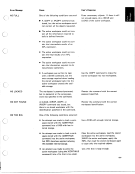Cause
The state indicator was made invalid
because one of the following occurred:
0 A function exists in the state indica-
tor list, but the function was erased.
0 A suspended function's header was
changed.
A label was removed or changed
on the suspended statement.
0 Statements were added to or erased
from a suspended function.
SYMBOL TABLE FULL More symbols were used than the number
of symbols allowed.
The symbol table in the stored work-
space is full and a load operation was
attempted. This error is caused by the
latent expression variable even if it
has not been assigned.
SYNTAX ERROR
SYSTEM ERROR
VALUE ERROR
The part of the statement indicated by
the caret (A) is syntactically invalid.
A malfunction occurred in the APL sys-
tem program and the data in the active
workspace is lost.
The object indicated by the caret (A)
has not been given a value:
0 If the object is a variable name, the
variable was not previously assigned
a value.
0 If the object is a function name, the
function header did not specify a
result, or the function did not assign
a value to the result variable.
User's Response
Use the )SI or )SIV command to display
the state indicator. Clear out the state
indicator by entering + repeatedly.
)SAVE the workspace, )CLEAR the active
workspace, increase the number of sym-
bols allowed by using the )SYMBOLS
command, then )COPY the stored work-
space into the active workspace.
Note: Erasing a symbol from the active
workspace does not remove it from the
symbol table; however, saving the active
workspace and loading it again will remove
any unused symbols from the symbol table.
Enter a corrected statement.
Enter the )CLEAR command; if the error
continues to occur, call your service
representative.
Note: If SYSTEM ERROR occurred on a
load or copy operation, the error may be
caused by a bad stored workspace file.
Try loading or copying another stored
workspace file to see if the error occurs
again.
Assign a value for the indicated variable or
correct the function so that it has an ex-
plicit result. The value must be assigned
before the object is used.
3
(3 \
3
3
186
The state indicator was made invalid
because one of the following occurred:
0 A function exists in the state indica-
tor list, but the function was erased.
0 A suspended function's header was
changed.
A label was removed or changed
on the suspended statement.
0 Statements were added to or erased
from a suspended function.
SYMBOL TABLE FULL More symbols were used than the number
of symbols allowed.
The symbol table in the stored work-
space is full and a load operation was
attempted. This error is caused by the
latent expression variable even if it
has not been assigned.
SYNTAX ERROR
SYSTEM ERROR
VALUE ERROR
The part of the statement indicated by
the caret (A) is syntactically invalid.
A malfunction occurred in the APL sys-
tem program and the data in the active
workspace is lost.
The object indicated by the caret (A)
has not been given a value:
0 If the object is a variable name, the
variable was not previously assigned
a value.
0 If the object is a function name, the
function header did not specify a
result, or the function did not assign
a value to the result variable.
User's Response
Use the )SI or )SIV command to display
the state indicator. Clear out the state
indicator by entering + repeatedly.
)SAVE the workspace, )CLEAR the active
workspace, increase the number of sym-
bols allowed by using the )SYMBOLS
command, then )COPY the stored work-
space into the active workspace.
Note: Erasing a symbol from the active
workspace does not remove it from the
symbol table; however, saving the active
workspace and loading it again will remove
any unused symbols from the symbol table.
Enter a corrected statement.
Enter the )CLEAR command; if the error
continues to occur, call your service
representative.
Note: If SYSTEM ERROR occurred on a
load or copy operation, the error may be
caused by a bad stored workspace file.
Try loading or copying another stored
workspace file to see if the error occurs
again.
Assign a value for the indicated variable or
correct the function so that it has an ex-
plicit result. The value must be assigned
before the object is used.
3
(3 \
3
3
186









































































































































































































































